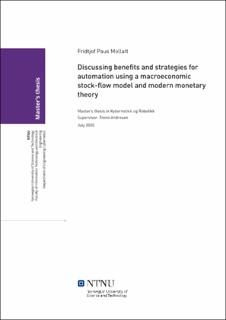| dc.contributor.advisor | Andresen, Trond | |
| dc.contributor.author | Mollatt, Fridtjof Paus | |
| dc.date.accessioned | 2021-09-23T18:20:13Z | |
| dc.date.available | 2021-09-23T18:20:13Z | |
| dc.date.issued | 2020 | |
| dc.identifier | no.ntnu:inspera:56990118:20963292 | |
| dc.identifier.uri | https://hdl.handle.net/11250/2780998 | |
| dc.description.abstract | Denne avhandlingen utvikler et rammeverk for å forstå hvordan automatisering påvirker samfunnet og ser på mulige framtidige utfall ved bruk av en makroøkonomisk stock-flow model som er basert på modern monetary theory.
1. Avhandlingen starter med å utforske hvordan automatisering og teknologi har påvirket samfunnet og arbeidere historisk sett. Makroøknomiske endringer i den industrielle revolusjonen blir brukt for å finne analogier til dagens situasjon. Den ser også på konsekvensene av utviklingen i automasjon og teknologi som gjør arbeidere mer produktive.
2. Denne avhandlingen omfavner modern monetary therory og påpeker noen av de mest essensielle kritiskkene de har av andre økonomiske retninger. I denne avhandlingen fokuseres det på makroøkonomiske tanker rundt statsbudsjettet, arbeidsmarkedet og arbeiderproduktivitet. Disse tankene brukes for å utvikle matematiske forhold i oppgaven.
3. For å gjøre rimelige konklusjoner fra observasjonene som blir gjort i oppgaven, diskuteres det hvordan vi vil at et framtidig samfunn skal se ut. Avhandlingen ser på vitenskaplig og filosofisk litteratur for å finne ut hvordan vi kan få samfunnet til å bli så bra som mulig.
4. Denne avhandlingen bruker en stock-flow modelleringstilnærming for å implementere og forstå the makroøkonomiske systemet. Derfor blir en seksjon av avhandlingen brukt til å forklare hva system dynamikk er og hvordan modellen er implementert.
5. Deretter blir de matematiske forholdene presentert og metodene som er brukt for å finne dem.
6. Deretter er simulasjonene utført og resulterende dynamikk og data er presentert og diskutert. Avhandlingen reflekterer deretter på dette og snakker om implikasjonene for samfunnet og veien videre, samtidig som verdien av en stock-flow tilnærming til sosialvitenskap blir diskutert. | |
| dc.description.abstract | This thesis develops a framework for understanding the impacts of automation on society and looks at the possible future outcomes using a macroeconomic stock-flow model based on modern money theory.
1. The thesis starts by examining the impacts automation and technology has had on the society and the individual labourer historically. In developing the framework, macroeconomic changes in the industrial revolution are used to find analogies to the situation we are in today. Further, it reports on the consequences of recent developments in automation and other technologies which makes human labour more productive.
2. The thesis embraces the modern monetary theory and points out some of its most essential criticisms of other economic schools of thought. This thesis focuses on the macroeconomic literature which concerns government spending, the labour market and labour productivity. These are all subjects which will be used later to set up the mathematical relationships and dynamics in the simulation part.
3. To make reasonable conclusions from the observations made in this thesis, it discusses what a prosperous future society might or should be. It draws upon different studies and literature which give a philosophical and scientific understanding of what we want the world to look like for the people living in it to be as prosperous as possible.
4. The thesis uses a stock-flow modelling approach to implement and understand the macroeconomic system.
Therefore a section of the thesis draws upon literature on system dynamics and stock-flow modelling and explains the method in detail. The models are explained through diagrams and screen captures of the actual
Simulink implementation. Later in the thesis are explanations for the mathematical methods and relationships used and the reasoning for choosing them. Then the parameters and implementation are explained.
5. Later in the thesis are explanations for the mathematical methods and relationships used and the reasoning for choosing them. Then the parameters and implementation are explained.
6. The simulations are then performed and the resulting dynamics and data are presented and discussed. The
thesis then reflects on it and talks about the societal implications of the findings and the value of using stock-flow modelling to get valuable insights on the past, present and future. | |
| dc.language | | |
| dc.publisher | NTNU | |
| dc.title | Discussing benefits and strategies for automation using a macroeconomic stock-flow model and modern monetary theory | |
| dc.type | Master thesis | |
